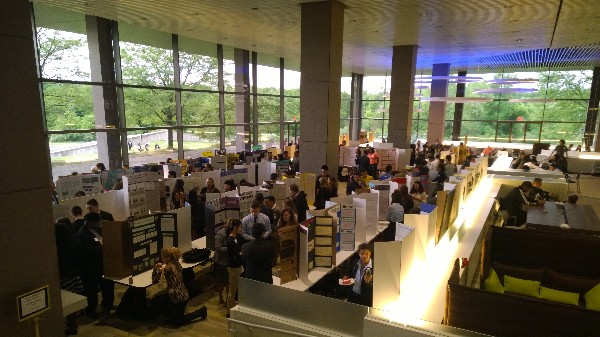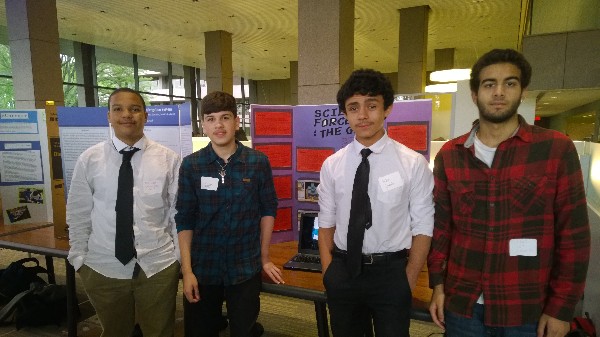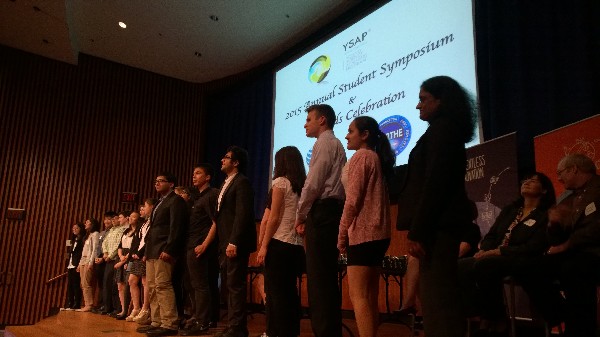High School Students Display STEM Contest Entries at AT&T's Global Network Operations Center

A science-themed video game, an ultrasonic proximity sensor and models of space-faring robots were just a few of the projects presented by high school students at the AT&T Global Network Operations Center, in Bedminster on June 4. The students were all participants in the Young Science Achievers Program‘s second annual STEM Competition, which included over 240 projects.
The Young Science Achievers Program (YSAP) is a nonprofit organization that started in 1988 at AT&T Bell Laboratories in Murray Hill. The program gives high school students resources as they develop research projects or inventions.
The students also benefitted from the help of the program’s mentors, like Dr. Wen-Ling Hsu, AT&T lead inventive scientist. Work on this year’s projects started in January, said Hsu, who works in big data research. She explained that she met with her students “two or three times a month. The last month or two was more intense. Every Wednesday night we met.”
The mentors “are professionals and engineers and scientists in the communities,” said Dr. Alicia Abella, executive vice president of YSAP and assistant vice president at AT&T. Abella added, “We also have other partner institutions, like Princeton University and Alcatel-Lucent, who have participated in this program over the years.”
Students participating in the June 4th event came from several schools in the New Jersey/New York metropolitan area. The projects presented were sorted into six categories: invention, physics, biology, chemistry, engineering and math. Like professional research and education proposals, the projects had to include a hypothesis, methodology, and an operating budget. The students could also apply for grants to help fund their projects.

At the June 4th event, students initially displayed summaries of their projects during a poster session, then moved into a large auditorium for the announcement of the winners. A group of STEM professionals selected the winners for each category.
The first place winner in the engineering category was “Science Force,” a role-playing video game that features famous figures such as Isaac Newton, Albert Einstein and Ben Franklin. Players must explore the game’s world and solve problems caused by a being from another universe. The students who created the game were Jaiell Taylor, Elias Feliz, Jesus Blondet and Pedros Canales, from Lincoln High School, in Yonkers, N.Y.

Their teacher, Dr. Dean Saghafi, told NJTechWeekly.com how students benefit from YSAP. “By being able to have the kids write for grants, [it] allows them to do the projects they want to do,” he said. “And the interest level in my classroom over the years has just skyrocketed.” He added that “when you’re working in a public school system, you’re limited by budgeting,” but the grants enable the students to pursue a wider variety of projects.
Another team from Lincoln High School created an ultrasonic proximity sensor to help people with impaired vision. To accomplish this, students Samuel Mesquita, Joshua Agyarko and Angel Antigua mounted an Arduino unit on a pair of glasses. The device emits ultrasonic waves, then measures the amount of time it takes for them to bounce back.
Mesquita said the device had been inspired by his mother, who suffers from retinitis pigmentosa. He explained that the eye condition causes symptoms such as tunnel vision.
Dylan Henry, of Weehawken High School, simulated space-faring robots to see how they would perform at three levels of gravity. “I used a simulation called ‘VoxCad,’ in which you use voxels, which are these little building blocks. And you have the voxels expand and contract like muscles,” he explained.
Henry said that he “used these voxels to create different types of robots. Some of them have legs, and some of them don’t have legs. And so I tried to make the best robot for different scenarios. To keep things simple, I only used three different scenarios.” These scenarios were normal Earth gravity, one tenth of Earth’s gravity, and ten times Earth’s gravity.
Henry noted that that the legged robots had “a really hard time” in heavy gravity, while the legless robots fared much better under the same conditions.
Projects like Henry’s were made possible in part by a $216,625 contribution from AT&T to YSAP. The money will also be used to fund similar YSAP programs in Dallas and Chicago.
The winning projects at the June 4th event were announced to an auditorium full of excited students, teachers and AT&T employees. The winners, by category, were:
Engineering
- Lincoln High School, Yonkers, N.Y.: Science Force Video Game
Biology
- Bergen County Academies, Hackensack, N.J.: Modulation of Neurotransmitters Using Nonivamide to Enhance Treatment of Depression
- Academy for Medical Science Technology, Hackensack, N.J.: The “Smart” Cancer Drug
- Bergen County Academies, Hackensack, N.J.: Control of Antibiotic Resistance in E Aerogenes via Inhibition of Conjugative Plasmid Dissemination
Chemistry
- Bayonne High School, Bayonne, N.J.: Creating Nano-Sized Particles of BCS 2 Class Cholesterol Drug
Math
- Bergen County Academies, Paramus, N.J.: The Mathematical Relationship between Social Media and Companies’ Stock Price
Physics
- Lincoln High School, Yonkers, N.Y.: Final Paper Impact of Degree Measurement of the Elbow on a Jump Shot
Invention
- Bridgewater-Raritan Regional High School, Bridgewater, N.J.: Nightmare in a Different Dimension
- Bridgewater-Raritan/Somerville High School (Joint Project), , N.J.: Xaboia – Turning Left Over Soap Into New Liquid Soap

